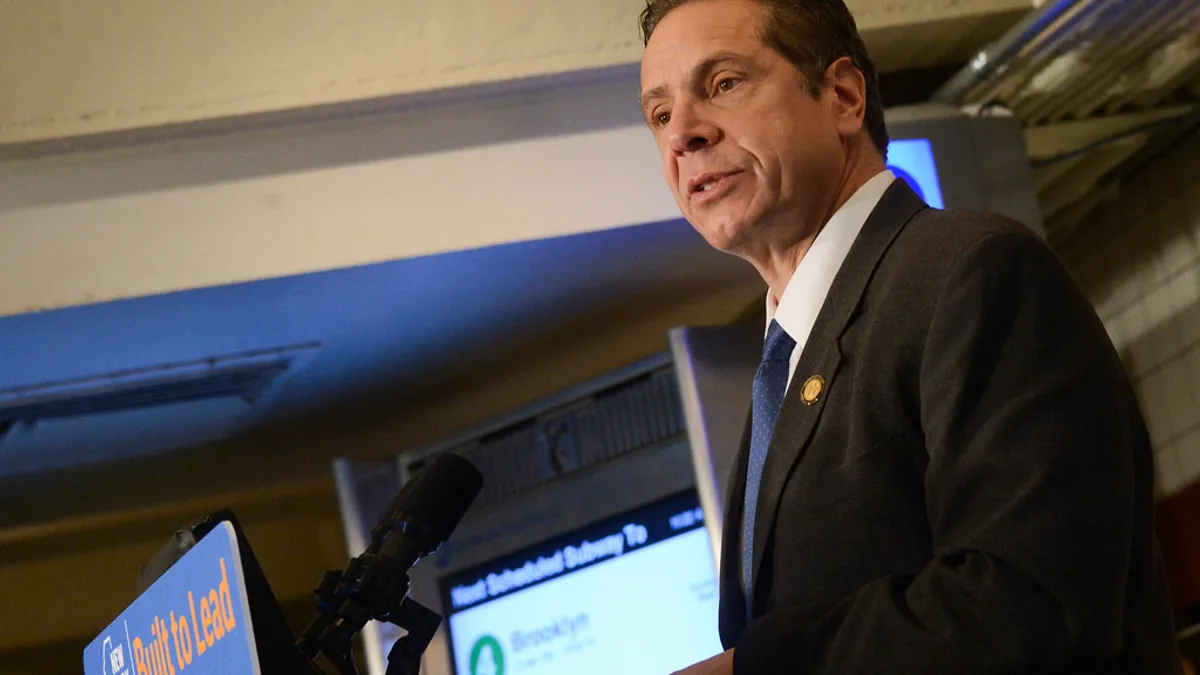Dive Brief:
-
New York Gov. Andrew Cuomo, D, on Monday pledged to bring New York to 100% carbon-free electricity by 2040 in a speech laying out his agenda for the first 100 days of 2019.
-
The pledge follows the New York Public Service Commission's Friday order approving plans to implement the third stage of its Clean Energy Standard (CES), which aims to reduce greenhouse gas emissions 40% by 2030 and 80% by 2050, with 50% of the state's electricity coming from renewables by 2030. And on Thursday, the commission approved the most ambitious energy storage target in the country — 3 GW by 2030 and 1.5 GW by 2025 — as well as a target aimed at doubling utility energy efficiency progress by 2025.
-
Energy storage has become a major focus of the state's groundwork toward its carbon-free goals, and the state also generates a third of its power from nuclear, noting in its CES fact sheet that "[m]aintaining safely operating upstate nuclear power plants will aid in the fight against climate change."
Dive Insight:
Cuomo's announcement adds to a growing number of state and city initiatives aimed at reducing carbon emissions, a response, in part, to federal inaction on climate change. As state leaders begin to tackle global warming on their own terms, many credit the groundwork that has already been laid in their state.
Last week, Washington Gov. Jay Inslee, D, committed his state to 100% clean energy by 2045, saying the goal was only possible "because we have done smart things up until now," including adopting a renewable portfolio standard, ramping up wind energy and adopting green transportation policies.
In Illinois, Gov.-elect J.B. Pritzker, D, has called for his state to reach 100% renewables generation by 2050. The state generates over half its energy from nuclear power but has been ramping up its solar portfolio as it looks toward a pure renewables goal.
New York, for its part, set its CES goals in August 2016, which "laid the groundwork to create enough renewable energy to meet half of the state's electricity needs by 2030," James Denn, public information officer for the New York PSC, told Utility Dive in an email. Along with its recent storage goals, New York recently issued an 800 MW offshore wind solicitation, part of Cuomo's goal to develop 2,400 MW of offshore wind by 2030.
"Through the Clean Energy Standard, New York has been able to attract billions of dollars in private investment for new renewable power supplies, while developing new jobs and clean energy choices for consumers," Denn wrote. "Adoption of the Phase 3 Plan is necessary for the continued implementation of the Renewable Energy Standard [RES] and allows NYSERDA to sell previously purchased Renewable Energy Credits [RECs] at a reduced cost to optimize the benefits for rate payers," he continued.
In September, the commission expanded the kinds of technologies eligible to meet the CES, including standalone storage, biomass generators and certain food-waste digestion configurations, among others.
On Friday, the commission clarified a few rules regarding the CES, allowing the New York State Research and Development Authority to sell RECs that are close to expiring and extending the deadline of the next CES progress report.
The governor's office expects to flesh out more details of the 100% clean energy plan in January.














